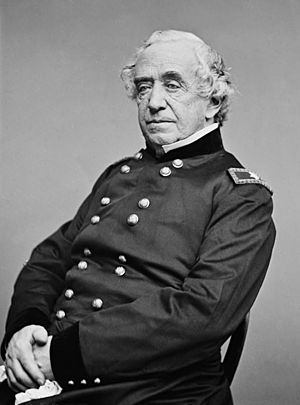Joseph Gilbert Totten facts for kids
Quick facts for kids
Joseph Gilbert Totten
|
|
|---|---|

Joseph Gilbert Totten
|
|
| Born | August 23, 1788 New Haven, Connecticut |
| Died | April 22, 1864 (aged 75) Washington, D.C. |
| Place of burial |
Congressional Cemetery, Washington, D.C.
|
| Allegiance | United States of America Union |
| Service/ |
United States Army Union Army |
| Years of service | 1805–1806, 1808–1864 |
| Rank | |
| Commands held | Corps of Engineers |
| Battles/wars | War of 1812 American Civil War |
| Relations | James Totten (brother) C. A. L. Totten (nephew) Joseph K. Mansfield (cousin) |
Joseph Gilbert Totten (born August 23, 1788 – died April 22, 1864) was a very important American military engineer. He played a key role in the War of 1812. Totten also served as the Chief of Engineers for the United States Army for a long time. He even helped create the National Academy of Sciences, which is a group of top scientists.
Contents
Early Life and Education
Joseph G. Totten was born in New Haven, Connecticut. His parents were Peter Gilbert Totten and Grace Mansfield. He was one of the first people to graduate from the United States Military Academy in 1805. He became a second lieutenant in the Corps of Engineers right after graduating.
In 1806, he left the army for a short time. He went to help his uncle, Major Jared Mansfield, who was a surveyor. A surveyor measures and maps land.
Joseph K. Mansfield, who became a major general, was his cousin. Joseph K. Mansfield sadly died during the Battle of Antietam in the Civil War.
Military Career and Engineering Feats
Totten rejoined the Corps of Engineers in 1808. He helped build important forts like Castle Williams and Castle Clinton in New York harbor. These forts protected the city.
Fighting in the War of 1812
During the War of 1812, Totten was the chief engineer for armies near Niagara and Lake Champlain. He worked under General Stephen Van Rensselaer. At the Battle of Queenston Heights, he fought alongside Winfield Scott. Scott even used Totten's necktie as a white flag to signal surrender.
Totten was recognized for his brave actions at the Battle of Plattsburgh. He was promoted to lieutenant colonel for his courage. After the war, he helped create important rules for building coastal defenses. These rules were used for many years.
Building Fort Adams
From 1825 to 1838, Totten was in charge of building Fort Adams in Newport, Rhode Island. This was a huge project. It was the second-largest army construction project in the 1800s. Only Fort Monroe in Virginia was bigger.
Totten taught young engineers from West Point at Fort Adams. He showed them advanced building methods. Some of his students became famous generals later. These included P. G. T. Beauregard and George Washington Cullum. While at Fort Adams, Totten also studied different types of mortar. He wrote a paper about his findings.
Chief Engineer and New Inventions
In 1838, Totten became the Chief of Engineers for the U.S. Army. He held this important job until he died in 1864. This was the longest time anyone has served as chief engineer. He was involved in almost everything the Army Corps of Engineers did. This included building forts and improving harbors.
Totten invented a special iron-reinforced opening for cannons. These were called "Totten shutters." They were hinged doors made of iron. They would open when a cannon fired and then quickly close again. This protected the soldiers from enemy fire. These shutters were used in forts like Fort Delaware and Fort Jefferson.
Mexican-American War and Civil War
General Scott greatly admired Totten. Totten was the chief engineer during the siege of Veracruz in the Mexican–American War. He helped plan how to attack the city.
Later, he served as a general in the Civil War for the Union Army. He was promoted to brigadier general in 1847. He received his permanent promotion to brigadier general in 1863.
The Minot's Ledge Lighthouse
One of Totten's most amazing achievements was designing the Minot's Ledge Light. This lighthouse is near Cohasset, Massachusetts. Earlier attempts to build a lighthouse on this rocky spot had failed. Totten came up with a plan to make the lighthouse very heavy. This way, its own weight would hold it firmly to the rock. It was built to withstand the worst storms.
This lighthouse still stands today. It flashes a unique light pattern: 1-4-3. Many people think this pattern means "I LOVE YOU."
Totten was promoted to major general on April 21, 1864. He had served in the army for almost sixty years. He died the next day from pneumonia in Washington, D.C.. He was buried in the Congressional Cemetery.
Places Named After Totten
Many places have been named in honor of Joseph G. Totten.
- Fort Totten in Washington, D.C., was a Civil War-era fort. It was part of the city's defenses. Today, some parts of the fort remain in Fort Totten Park. A neighborhood, an apartment building, and a Metro station in D.C. are also named after him.
- Fort Totten (Queens) is a historic former U.S. Army fort in New York City.
- Fort Totten, North Dakota is a historic site named for him. It is on the National Register of Historic Places.
- Totten Key is an island in Biscayne Bay near Miami. Robert E. Lee surveyed the area in 1850 and named the key after Totten.
- Totten Street is located on Fort Leonard Wood in Missouri.

